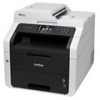Brother International MFC-9340CDW Network Users Manual - English - Page 124
TELNET, SNMP, LLMNR, Web Services, HTTP, FTP (for the Scan to FTP feature), Network
 |
View all Brother International MFC-9340CDW manuals
Add to My Manuals
Save this manual to your list of manuals |
Page 124 highlights
Types of network connections and protocols TELNET 9 The TELNET protocol allows you to control the remote network devices on a TCP/IP network from your computer. SNMP 9 The Simple Network Management Protocol (SNMP) is used to manage network devices including computers, routers and Brother network ready machines. The Brother print server supports SNMPv1, SNMPv2c and SNMPv3. NOTE For details of the SNMPv3 protocol, see Security protocols on page 134. LLMNR 9 The Link-Local Multicast Name Resolution protocol (LLMNR) resolves the names of neighboring computers if the network does not have a Domain Name System (DNS) server. The LLMNR Responder function works in both the IPv4 or IPv6 environment when using a computer that has the LLMNR Sender function such as Windows Vista®, Windows® 7 and Windows® 8. Web Services 9 The Web Services protocol enables Windows Vista®, Windows® 7 or Windows® 8 users to install the drivers used for printing and scanning by right-clicking the machine icon from the Network folder. (See Installing 9 drivers used for printing and scanning via Web Services (Windows Vista®, Windows® 7 and Windows® 8) on page 128.) For details about scanning using Web Services: see Software User's Guide. The Web Services also lets you check the current status of the machine from your computer. HTTP 9 The HTTP protocol is used to transmit the data between a web server and a web browser. NOTE For details of the HTTPS protocol, see Security protocols on page 134. FTP (for the Scan to FTP feature) 9 The File Transfer Protocol (FTP) allows the Brother machine to scan black and white or color documents directly to an FTP server located locally on your network or on the Internet. 118















